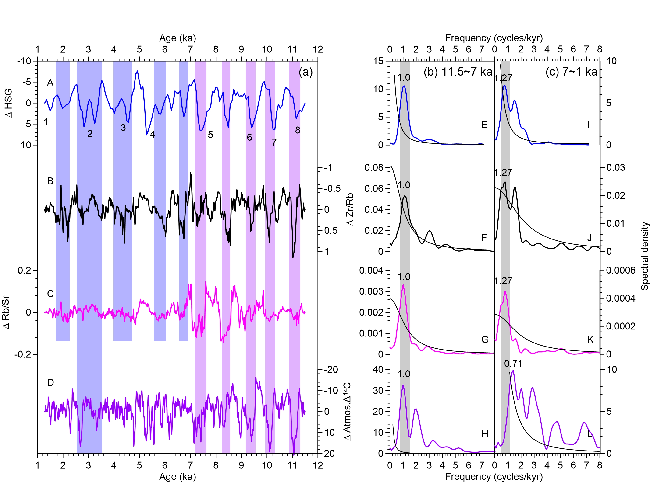The East Asian monsoon (EAM) is one of the most important atmospheric circulation systems linked to climate changes over high- and low-latitude regions of the Northern Hemisphere.
Variability in the rain-bearing East Asian summer monsoon (EASM) on a millennial to centennial timescales has been investigated extensively from different sediments and model simulations. These previous studies showed a series of oscillations and/or abrupt events, such as the 4.2 ka, 8.2 ka, 9.2 ka and 10.3 ka events.
Unlike abundant proxies of the EASM variability, highresolution records reflecting millennial to centennial East Asian winter monsoon (EAWM) variability are still sparse due to the low resolution of loess sediments, controversial proxies and age uncertainty.
Recently, a research team led by Prof. SUN Youbin from the Institute of Earth Environment (IEE) of the Chinese Academy of Sciences provided valuable insights into the relationship between the EAWM and EASM variability at centennial to millennial timescales and the links with external solar forcing and internal feedbacks. Their findings were published in Climate of the Past.
They presented a high-resolution scanning X-ray fluorescence (XRF) analysis of a 13.5 m terrace succession on the western Chinese Loess Plateau (CLP) to infer rapid monsoon changes since the last deglaciation.
Their results indicated that Rb/Sr and Zr/Rb were sensitive indicators of chemical weathering and wind sorting, respectively, which were further linked to the strength of the EASM and EAWM.
During the last deglaciation, two cold intervals of the Heinrich event 1 and Younger Dryas were characterized by intensified winter monsoon and weakened summer monsoon. The EAWM gradually weakened at the beginning of the Holocene, while the EASM remained steady till 9.9 ka and then grew stronger.
Both the EASM and EAWM intensities indicated a mid-Holocene climatic optimum. Rb/Sr and Zr/Rb exhibited an antiphase relationship between the summer and winter monsoon changes on a centennial timescale during 16–1 ka.
Comparison of these monsoon changes with solar activity and North Atlantic cooling events revealed that both factors could lead to abrupt changes on a centennial timescale in the Early Holocene. During the Late Holocene, North Atlantic cooling became the major forcing of centennial monsoon events.

Fig.1 Map showing (a) the CLP and location of the DDW, (b) photographs of DDW terrace outcrop, and (c) cores. (Image by LIU Xingxing, et al.)

Fig.2 (a–d) Centennial components of (b) Zr/Rb and (c) Rb/Sr with (a) the North Atlantic HSG (Bond et al., 2001) and (d) atmo[1]sphere 14C record (Reimer et al., 2013). The purple and blue bars indicate abrupt monsoon events. Plots (e–l) show the spectra of the proxy records during the (e–h) Early and (i–l) Late Holocene. Spectral peaks that are above the 80 % confidence levels (black lines) are marked. The grey vertical bands indicate the most significant cycle. (Image by LIU Xingxing, et al.)
Contact: Bai Jie, Institute of Earth Environment, Chinese Academy of Sciences, Xi'an, China. Email: baijie@ieecas.cn
 © 2015 Institute of Earth Environment,CAS
© 2015 Institute of Earth Environment,CAS Address:No. 97 Yanxiang Road, Xi'an 710061, Shaanxi, China

 Location :
Location :